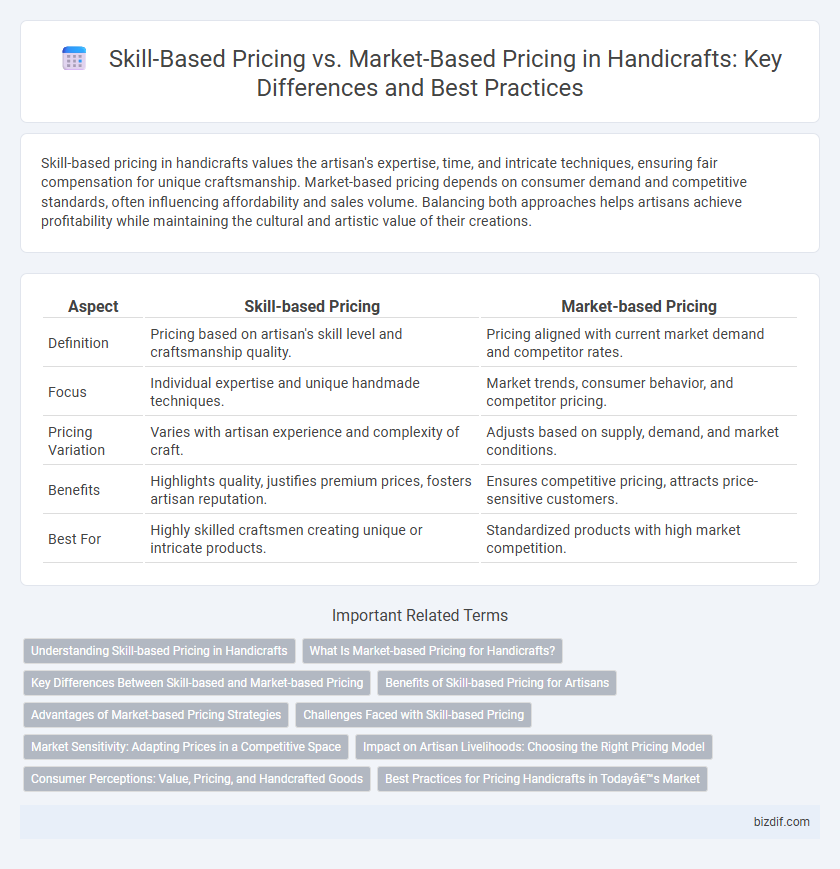Skill-based pricing in handicrafts values the artisan's expertise, time, and intricate techniques, ensuring fair compensation for unique craftsmanship. Market-based pricing depends on consumer demand and competitive standards, often influencing affordability and sales volume. Balancing both approaches helps artisans achieve profitability while maintaining the cultural and artistic value of their creations.
Table of Comparison
| Aspect | Skill-based Pricing | Market-based Pricing |
|---|---|---|
| Definition | Pricing based on artisan's skill level and craftsmanship quality. | Pricing aligned with current market demand and competitor rates. |
| Focus | Individual expertise and unique handmade techniques. | Market trends, consumer behavior, and competitor pricing. |
| Pricing Variation | Varies with artisan experience and complexity of craft. | Adjusts based on supply, demand, and market conditions. |
| Benefits | Highlights quality, justifies premium prices, fosters artisan reputation. | Ensures competitive pricing, attracts price-sensitive customers. |
| Best For | Highly skilled craftsmen creating unique or intricate products. | Standardized products with high market competition. |
Understanding Skill-based Pricing in Handicrafts
Skill-based pricing in handicrafts involves setting prices according to the artisan's expertise, complexity of techniques, and time invested, ensuring fair compensation for unique craftsmanship. This approach values intricate handwork and specialized skills that differentiate products in niche markets. Emphasizing skill-based pricing helps artisans maintain sustainable livelihoods while promoting high-quality, exclusive handmade goods.
What Is Market-based Pricing for Handicrafts?
Market-based pricing for handicrafts sets product prices according to current market demand, competitor pricing, and consumer willingness to pay rather than solely focusing on production costs or skill level. This strategy involves analyzing similar handcrafted items in local and online marketplaces to determine competitive price points that maximize sales and profitability. Craft sellers using market-based pricing adjust their rates based on trends, customer preferences, and seasonal fluctuations to remain relevant and competitive.
Key Differences Between Skill-based and Market-based Pricing
Skill-based pricing in handicrafts sets costs according to the artisan's expertise, craftsmanship quality, and the time invested, emphasizing uniqueness and skill value. Market-based pricing relies on prevailing industry rates, customer demand, and competitor prices to determine the selling price, prioritizing market trends and consumer willingness to pay. The key difference lies in skill-based pricing valuing individual artisan proficiency, while market-based pricing aligns price with external economic factors and market conditions.
Benefits of Skill-based Pricing for Artisans
Skill-based pricing enables artisans to capture the true value of their craftsmanship by aligning prices with their expertise and the complexity of their work. This approach encourages continuous skill development and fosters a unique brand identity, setting artisans apart in competitive markets. Higher compensation reflects the dedication and intricate techniques involved, promoting sustainable income growth for handcrafted products.
Advantages of Market-based Pricing Strategies
Market-based pricing strategies allow handicraft artisans to align product prices with current consumer demand and competitive offerings, enhancing market competitiveness. This approach enables flexible pricing adjustments based on market trends, increasing sales potential and customer satisfaction. By leveraging real-time market data, artisans can optimize profit margins while maintaining relevance in dynamic craft markets.
Challenges Faced with Skill-based Pricing
Skill-based pricing in handicrafts often faces challenges due to the difficulty in accurately quantifying the artisan's expertise and time investment, leading to pricing inconsistencies. Market demand fluctuations and customer perception of value further complicate setting fair prices based solely on skill level. This approach risks undervaluing unique craftsmanship when competing with standardized market prices or mass-produced alternatives.
Market Sensitivity: Adapting Prices in a Competitive Space
Market-based pricing in handicraft emphasizes responding to competitor prices and consumer demand fluctuations, ensuring products remain appealing within a dynamic marketplace. It enables artisans to adjust prices rapidly in response to seasonal trends and market saturation, maintaining competitiveness. Such sensitivity helps balance profitability with market acceptance, crucial for sustaining sales in a crowded handicraft industry.
Impact on Artisan Livelihoods: Choosing the Right Pricing Model
Skill-based pricing directly values the unique craftsmanship and expertise of artisans, often leading to higher earnings and improved livelihoods by reflecting the true effort behind each handicraft piece. Market-based pricing aligns product prices with consumer demand and competitor rates, which can result in more consistent sales but may undervalue specialized skills. Opting for a pricing model that balances skill recognition with market trends ensures artisans achieve sustainable income and business growth.
Consumer Perceptions: Value, Pricing, and Handcrafted Goods
Consumer perceptions of handcrafted goods often hinge on the perceived value derived from the artisan's unique skills and craftsmanship, which justifies higher skill-based pricing. Market-based pricing, however, emphasizes competitive pricing aligned with similar handcrafted products, influencing consumer expectations around affordability and value. Understanding the balance between these pricing strategies is crucial for artisans to effectively communicate quality and uniqueness to consumers while maintaining market relevance.
Best Practices for Pricing Handicrafts in Today’s Market
Skill-based pricing for handicrafts emphasizes the artisan's expertise, time, and craftsmanship, ensuring that unique creations reflect their true value. Market-based pricing aligns product prices with current consumer demand, competitor pricing, and regional trends to remain competitive and attractive. Combining both approaches, artisans should conduct thorough market research and evaluate their skill level to set prices that maximize profit while maintaining authenticity and customer appeal.
Skill-based Pricing vs Market-based Pricing Infographic

 bizdif.com
bizdif.com